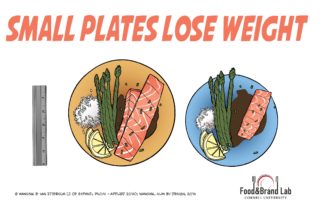Are you on the “See-Food Diet”?
Imagine this scene – you just left the dinner table and are headed for the TV room. No sooner do you sit down than you feel an “urge to eat”. You wander into the kitchen and search your cupboards, fridge and freezer hoping that you will encounter something that you feel like eating and not just boring fruits and veggies. You wander back to the TV room with chips or ice cream or cookies or…………. And then you hear those words – “Didn’t you JUST eat?”
Many of us have had this experience and have probably even wondered “how could I possibly feel hungry so soon after eating?” The answer is quite simple. You were NOT hungry. Instead you had an URGE TO EAT. The triggers for an urge to eat are not internal but external. They exist in your environment at home, at work, at the restaurant, at the cottage – in fact, everywhere that you eat. Dr. Brian Wansink, professor and director of the Cornell Food and Brand Lab and author of Slim by Design: Mindless Eating Solutions for Everyday Life, refers to this as the “See-Food Diet” – you eat what you see.

Wansink’s premise is to re-engineer our environment and eating habits so that we can eat enjoyably and mindfully without guilt and weight gain. His mantra is: the best diet is the one you don’t know you’re on. This is good news because you can actually make some very small, easy changes that will result in you eating and weighing less in the future. You can make changes that will help protect you against mindless eating.
Here are 10 simple changes for you to try in your home.
- You are likely to eat what you can see. Clear your kitchen counter of snacks, cereal boxes, pop, etc.
- We tend to eat more in cluttered, chaotic kitchens. Spend some time decluttering your kitchen and moving things out of sight.
- When you open the fridge door you are most likely to choose something to eat from the top or middle shelf. Use your crisper bins to store the foods that you find most appealing and move the fruits and veggies to the top shelf.
- When you eat in many locations in your home such as the dining room, the kitchen, the bedroom, the den, the office, etc., you “condition” yourself to have an urge to eat in all of those locations. Establish one place in your home where ALL of your eating will take place. You can eat what you want, but it must be in that location.
- The larger the plate, the more you will eat. Swap your 14 inch plates for a 10 or 12 inch plate and you will eat less and lose weight.
- When you buy groceries in bulk, you will eat most of it in the first week and then less from that point on. Either buy smaller portions, even if the cost is slightly higher, or repackage foods when you get home from the store and put them in a less accessible place.
- The more hassle it is to eat, the less we eat. Store the foods that tempt you the most in locations that require more effort for you to access such as a room in the basement or a fridge in the garage.
- When food is served from bowls sitting on the dining table, we eat more. Serve your plate at the kitchen counter. Even better, store the leftover food in the fridge before you sit down to eat.
- Wrap leftovers in tinfoil rather than transparent wrap. No see – no eat!!!
- Change “eating scripts” from weight gain scripts to weight loss scripts: re-script dinner – start last, pace with the slowest eater, leave some food on your plate, decide how much to eat before the meal.
Practice the Power of Three: Choose 3 easy changes that you can mindlessly make, without a lot of sacrifice. If you choose 3 ways to save 100 calories per day, you can lose 30 pounds this year, and develop healthy diet habits.
![]()

